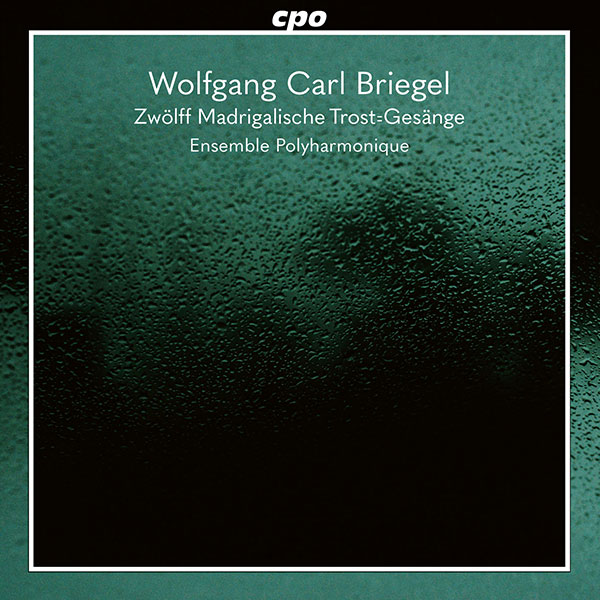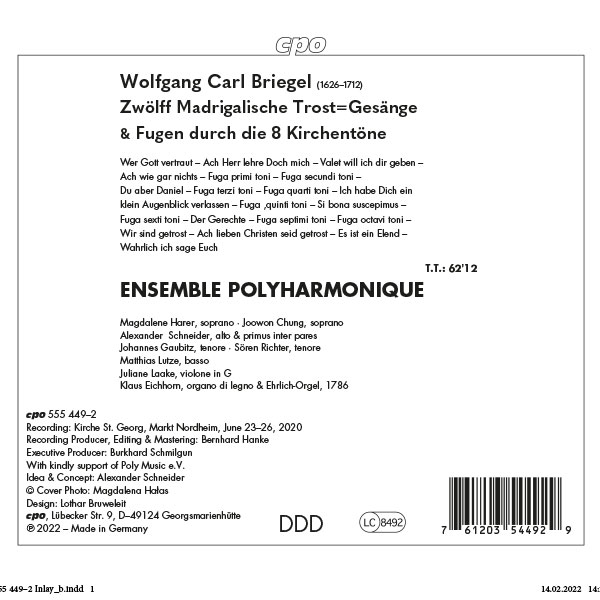Wolfgang Carl Briegel’s Zwölff madrigalische Trost-Gesänge
“Ende gut, Alles gut.” All’s well that ends well. These were the consolatory words around which Wolfgang Carl Briegel (1626–1712) formulated the dedication of his Zwölff madrigalische Trost-Gesänge (5 and 6 voices, bc) in 1671. After more than two decades of continuous service at the ducal court in Gotha, Briegel was leaving his position as Hofkapellmeister and, with this publication of twelve funerary pieces, bidding solemn farewell to his sovereign, Ernst I, Duke of Saxe Gotha [Herzog zu Sachsen-Gotha] (1605–75).
Born in Königsberg (Lower Franconia [Unterfranken]), an exclave of the Duchy of Saxe-Gotha [Herzogtum Sachsen-Gotha], Briegel received his initial musical training under Johann Andreas Herbst (1588–1666) in Nuremberg. Through Herbst, Johann Erasmus Kindermann (1616–45) and others, Briegel was exposed vicariously to the latest Italian styles of composition and performance. He studied briefly at the university in nearby Altdorf, and from 1645 was employed as organist at the Johanniskirche and teacher in the Lateinschule in Schweinfurt. In 1650, he accepted a position at the ducal court in Gotha where eventually he would rise to the position of Kapellmeister.
Ernst I, Duke of Saxe-Gotha, also known as “der Fromme” (the Pious) was not only a devout Lutheran and a tireless Reformer, he proved to be a capable and enlightened ruler. Lutherans fleeing religious persecution in other countries found refuge under Ernst. He introduced numerous social programs, overhauled the judicial system in his domain, and in 1642 issued a progressive School Ordinance (Schulordnung) which, among other things, mandated a formal education for children between the ages of 5 and 12. Schloss Friedenstein, stately home to the ducal family, was built over a ten-year period beginning in 1643 and was one of the largest princely residences constructed during the Thirty Years’ War.
During his tenure at the Gotha court, Briegel produced large amounts of sacred and secular music for a wide variety of functions and occasions, which brought him to the attention of Johann Rudolf Ahle and members of the Bach family. He was personally responsible for the musical education of the duke’s children, and even the duke’s consort, Duchess Elisabeth Sophia, received tuition from him. As tutor, Briegel instructed the children in both vocal and instrumental music, but this was cut tragically short: three of his young pupils died within days of each other during a smallpox outbreak in December 1657. Instead of bringing music into their lives, Briegel now found himself providing music for their funerals. The eldest, however, Elisabeth Dorothea (1640–1709) was spared, thrived, and was esteemed by Briegel for her “great inclination, fine understanding and qualities in vocal as well as in instrumental music.” [ “… hohe Zuneigung, guten Verstand und Qualitäten so wohl in der Vocal- als Instrumental-Music.”]
Elisabeth Dorothea was married to Ludwig VI, Landgrave of Hesse-Darmstadt (1630–78) in December 1666 and had hoped to bring Briegel to the Darmstadt court. Ernst resisted at first. By 1670, old, frail and ever mindful of his mortality, he granted Briegel his dismissal, and by early 1671 the composer bore the title “Fürstl. Hessischer Kapellmeister zu Darmstadt,” a position he would retain for the rest of his remarkably long life. In dedicating a collection of consolatory funeral music as a farewell to Ernst, Briegel expressed his profound gratitude to his erstwhile employer in whose service he had devoted so many years; Ernst, at the same time, will have accepted these gifts in a positive light, as soothing reminders that a Christian death is to be welcomed by those whose lives are spent in humble service to their Saviour and Redeemer. Briegel states repeatedly in his farewell address to Duke Ernst, as do the texts themselves of these Trost-Gesänge, that in life as in death, “All is well that ends well,” “Ende gut, Alles gut.”
Musical Style in the Trost-Gesänge
Despite Briegel’s title for this collection, not all the pieces in it are what one would call “madrigalisch” (“madrigalian”). In fact, only slightly more than half of Briegel’s Gesänge are settings of scriptural texts as so-called Spruchmotetten, an approach to comparable madrigal composition wherein each phrase of sacred text receives its own musical treatment. His collection rather demonstrates an array of inventive approaches to setting biblical and poetic texts. In one instance (Wer Gott vertraut), a sixteenth-century chorale text by Joachim Magdeburg is set in something of a hybridized musical style, somewhere between motet and simpler homophonic chorale settings. Two others (Ach, Herr, lehre doch mich and Ach, wie gar nichts) are for the most part through-composed settings of scriptural passages, but Briegel abruptly interrupts the forward movement with robust interjections of chordal statements of well-known chorale texts and melodies. The opening work to the collection, Du, aber Daniel, is a polytextual chorale motet, a genre favoured amongst Protestant composers of Middle Germany. Here the composition begins with the core biblical text (Dan 12:13) set to newly composed music sung by the lowest three voices (TTB). A familiar chorale text and melody (So fahr ich hin zu Jesu Christ) are unexpectedly heard in extended note values in the uppermost voice (S), and at the same time a third newly composed melody and biblical text from Revelation [Offenbarung] (14:13) is added in an inner voice (A).
What the listener hears is one consoling message expressed simultaneously from three authoritative perspectives: Old Testament, chorale [Kirchenlied], and New Testament. Yet another of Briegel’s approaches can be heard in Valet will ich dir geben and Ach, lieben Christen, seid getrost. These are treatments of familiar chorale texts and melodies, largely chordal in their settings but enriched through colourful vocal combinations, emphatic repetitions of text, and polychoral effects.
Briegel’s skill as a contrapuntist pervades these works. Imitative entries are balanced against quasi-polychoral effects. Full-voiced homophony is used sparingly and in contrast to the subtle and varied combinations of voices. Textures are generally transparent as Briegel cycles through an evolving palette of vocal colours and combinations. This cycling of material, in addition to changes of metre, tempo and dynamics, and graduated increases in rhythmic activity build to give the compositions a sense of growing momentum.
Briegel did not conceive this collection of twelve funerary pieces as a series to be performed from start to finish. They are individual, consolatory lessons, companions or aids to spiritual reflection. In order to accommodate and present the works effectively for the listener, Ensemble Polyharmonique creates a programme that reflects a kind of baroque proportion, whereby the groupings and arrangement of material for the first half of the programme are mirrored in the second half, the structural pivot comprising the lone Latin-texted work in Briegel’s collection, Si bona suscepimus. To help define and articulate this balanced design, a series of organ fugues composed by Briegel have been interpolated into the programme, one in each of the eight church modes. The fugues are relatively brief works, yet they are richly varied thematically and exhibit the particular character and properties of each mode.
The Ehrlich Organ in Markt Nordheim
The organ used to accompany several of the vocal performances and for the eight fugues was by built for the St. Georg Kirche in Markt Nordheim by Johann Bernhard Ehrlich in 1786, preserving some of the parts of the instrument it replaced. The organ was subjected to extensive modernization in the twentieth century but now, after careful restauration between the years 2017 and 2019, it has been returned to its original state. That includes a higher tuning for the instrument (A=473 Hz), slightly more than a semitone above modern concert pitch. Consequently, and fully in keeping with historical practices, some of the pieces recorded here have been transposed downward the better to accommodate the voices.
Gregory S. Johnston


